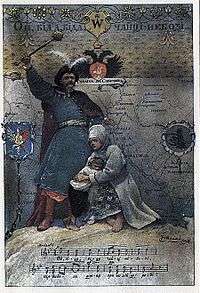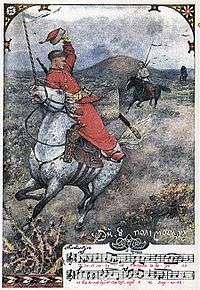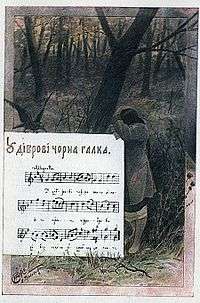Cossack’s songs of Dnipropetrovsk Region
Dnipropetrovsk’s Cossack songs (Ukrainian:Козацькі пісні Дніпропетровщини) or "Cossack songs" are the phenomenon of singing steppe songs (Ukrainian Cossack songs) in the Dnipropetrovsk region, listed as an intangible cultural heritage in need of urgent protection.[1][2][3]
Description
Cossack songs are a male singing tradition characteristic to Cossacks.[4]
First of all, can be considered "Cossack songs" are songs in which describes Cossack campaigns (such as "Oj, huk, maty, huk" the village Kapulivka Nikopol region), songs about Cossack leaders (for example, song about Cossack’s Colonel - Daniel Nechay " Oy z-za hory ta shche y z-za lymanu" from the city Zhovti Vody) Cossack's lyrics (example " Iz-za hir, z-za hir" from the city Pidhorne) Cossack song (example, "Ishov kozak z Donu " from the village Velikomihaylovka, Pocrovskiy region). In these songs story told by uncertain narrator, or from the Cossack.[2]
To some extent, "Cossack songs" can be considered the song, which describe relations between Cossacks and girl. Although these songs are usually told by the girl, while their musical language is identical to the first group of songs (perhaps with the exception of the Cossack song) (e.g. "Sadomsadom, pshenychenka lanom" from village Boundary Mezhova region).[2]
However, not all songs about Cossacks are Cossack songs. To Cossack themes turned songwriters, created during the struggle for independence of Ukraine 1917-1921, for example, the song " Jichav kozak na vijnonku" or "Stojt kozak na chornij kruchi" These songs were performed in the villages, but older performers disparagingly called to these songs, calling them "tryndychkamy" (example, in the village Kocherezhky Pavlograds'kyy region).[2]
Musical language of Cossack songs peculiar full and well tunes, the length of each musical phrase (folk singers from the village Kapulivka Nikopol region called this type of song "prolonged"), a significant duration of time of each music piece, even some sounds; Lyrics often "lost" in a melodic chant some warehouses; occurs as artistic device, not full singing individual words while beginning another musical phrase. When performing songs performers concentrated inherent self-absorbed, a condition close to the prayer-meditation. Cossack songs are performed without accompaniment of musical instruments, generally together (with the exception of songs belonging to the repertoire of harpers, Bandura performed solo, often accompanied by bandura, another 15 – 20 years ago could talk about balance Kobzar household tradition in Nikopol area but today the absence of continuity phenomenon is low).[2]
For group's Cossack song structure inherent solo solo voice and solo voice top. These features folk performers, called verbs "start" and "output" ( "pull"). Under the influence of folk choirs upper voice can carry a group of people (such as in a folk ensemble "discovery" of the city Zhovti Vody). This leads to simplification of the upper melody voice, loss of performance personality. Wholesale of song usually has three voice structure (top solo voice and wholesale middle and lower voice). The village Bohuslav Pavlograds'kyy area in some songs women add fours voice, the lowest voice, in fact, is an imitation of the male party ( "bas").[2]
Cossack songs performed normally saturated loud sound from its formation in the chest, and the manner of execution is common for both men and women.
Cossack songs nowadays often performed by women themselves, rarely mixed groups. Wholesale men's singing is a relict phenomenon, although the memory of women whose youth came in the first half of the 20th century, wholesale men's singing were extremely common. Last male specimens wholesale songs recorded in 2000 in the village of Gavrilovka Pocrovsciy District manager folk ensemble "Buttya" (Kyiv) Oleg Booth and early 2000s, folklorists Oles Honchar Dnipropetrovsk National University in Pischcahnka village Novov'yazivok and village gerbil Novomoskovsk region.[2]





Holders
Holders of "Cossack songs Dnipropetrovsk" do not constitute a single community. In some places they are united in amateur folk groups, such as in Yellow Waters (ensemble "Znahidka") in Suburban Dnipro region (Ensemble "Krunutsya"), in the village of Bohuslav Pavlograds'kyy region (Ensemble "Bohuslavochka") . Elsewhere holders of "Cossack songs" are persons who do not participate in artistic groups, such as those for 2014 are: Anna Mikhaylovna Dolzhanskiy, 1918 year of birth of the village Boundary Mezhova Raion; Catherine G. Skiba, 1929 was born in the village of Krasny During Shyroke Raion) or informal groups that meet on occasion (weekends, holidays, just sing near house) (for example, a group in the village Kapulivka Nikopol region consisting of: Fedorenko Hope S., 1927 born Maria Ivanchura Kindrativna, 1934 year of birth, Belyaev Olga G., born in 1930).[4]
Maria Zauholna, member of folk-ethnographic ensemble "Krynytsya," admitted that the group held exclusively on the enthusiasm of older women. People singing gradually died: young people not interested in it, officials do not support. Geographical location and area of existence
The geographical area of distribution Cossack songs covering almost all the Dnipropetrovsk region, except in villages where densely populated by other nationalities such as Russians, Belorussians . Cossack songs Dnipropetrovsk distributed throughout the Dnepropetrovsk region, as evidenced by folklore expeditions conducted in the early 2000s, experts NDL Ukrainian folklore, folk literature and dialect of the Lower Dnieper Oles Honchar Dnipropetrovsk National University and members of the Ukrainian Association of Young Researchers folklore. At that time considerable achievements in preserving folk songs, in that those of Cossack songs are in Zhovti Vody, villages Debaltseve Vasylkiv region village Inhulets Krivoy Rog area, Hupalivka, Lychkove Magdalinovskiy and Mogilev region; Boundary Mezhova region; Kapulivka Nikopol region; Golubovka, Pischchanka, Ivano-Mikhaylovka Novomoskovsk region; Kocherezhky, Bohuslav, Mezhyrich, Vyazivok Pavlograds'kyy area; Oleksiivka, Ekaterinovka, United Mykhailivka, Havrylivka, Romanko Povcrovskiy region; Kalinovka, Sursko-Mykhailivka, farm Hroza, village Solone Solonyansky area; Dobra Nadiya Tomakivskyregion area; Turove, Mohyliv, Tsybulʹkivka Tsarychans'kyy area; Krasnyy Pid, Novokursʹke Shyroke area; Novov'yazivok Yurivsk area. Expedition that conducted in 2014, revealed the following regions preserve this element - villages Kapulivka Nikopol district Bohuslav Pavlograds'kyy region Krasny Pid and Novokurske Shyroke region, the village Boundary Mezhova Raion, cities Vody, Suburban, village Sursko-Mikhaylovka Solone area.[4]
We know that cossacks in Ukraine began take shape precisely with the Lower Dnipro (last 5 Zaporizhzhya Sich, from 1581 to 1775 years, located in what is now the Dnipropetrovsk region), Cossack songs that existed in the area, also entered into other areas of Ukraine, while there are acquired other features and character. In addition, the elucidation of their state of existence now requires relevant research.[4]
Tangible items
Now there is no material objects related to the practice of Cossack songs. In historical perspective, the performance of solo songs Cossack bandura could be used.[1]
Research
The study Cossack songs during folklore expeditions engaged in the research laboratory of folklore, folk dialects and literature Lower Dnieper Oles Honchar Dnipropetrovsk National University and Ukrainian Association of Folklore young researchers under the leadership of Ilya Fetisov.
Protection
Currently songs fixing involving scientists researchers Ukrainian folklore. At the executive level authorities of Ukraine introduced a program of preservation and development of cultural and natural heritage located in the Dnepropetrovsk region, in 2014–2019 years . There digitization and identification records of previous years. Consultations with experts, media element "Cossack songs Dnipropetrovsk" (including the heads of folklore groups that represent Cossack songs Dnipropetrovsk), and interested institutions and organizations whose purpose is the transfer of Cossack songs Dnipropetrovsk younger generation.[1]
List of Intangible Cultural Heritage
2014 in Dnepropetrovsk region began the initiative group of nomination dossier for inclusion Cossack songs end to the UNESCO list of security
November 28, 2016, the Committee for the Protection of Intangible Cultural Heritage List included Cossack songs Dnipropetrovsk region on the List of Intangible Cultural Heritage in need of urgent protection. According to the Committee, these works "sung Cossack communities in the region and talk about the tragedy of war and the personal experiences of soldiers-Cossacks. Lyrics maintain spiritual ties with the past, but can also carry entertaining ".[1]
References
- 1 2 3 4 Cossack’s songs of Dnipropetrovsk Region
- 1 2 3 4 5 6 7 Oblokova kartka «Dnipropetrovsk’s Cossack songs»
- ↑ Traditions from Portugal, Uganda and Ukraine inscribed on the List of Intangible Cultural Heritage in Need of Urgent Safeguarding
- 1 2 3 4 Dnipropetrovsk’s Cossack songs. What does it change?